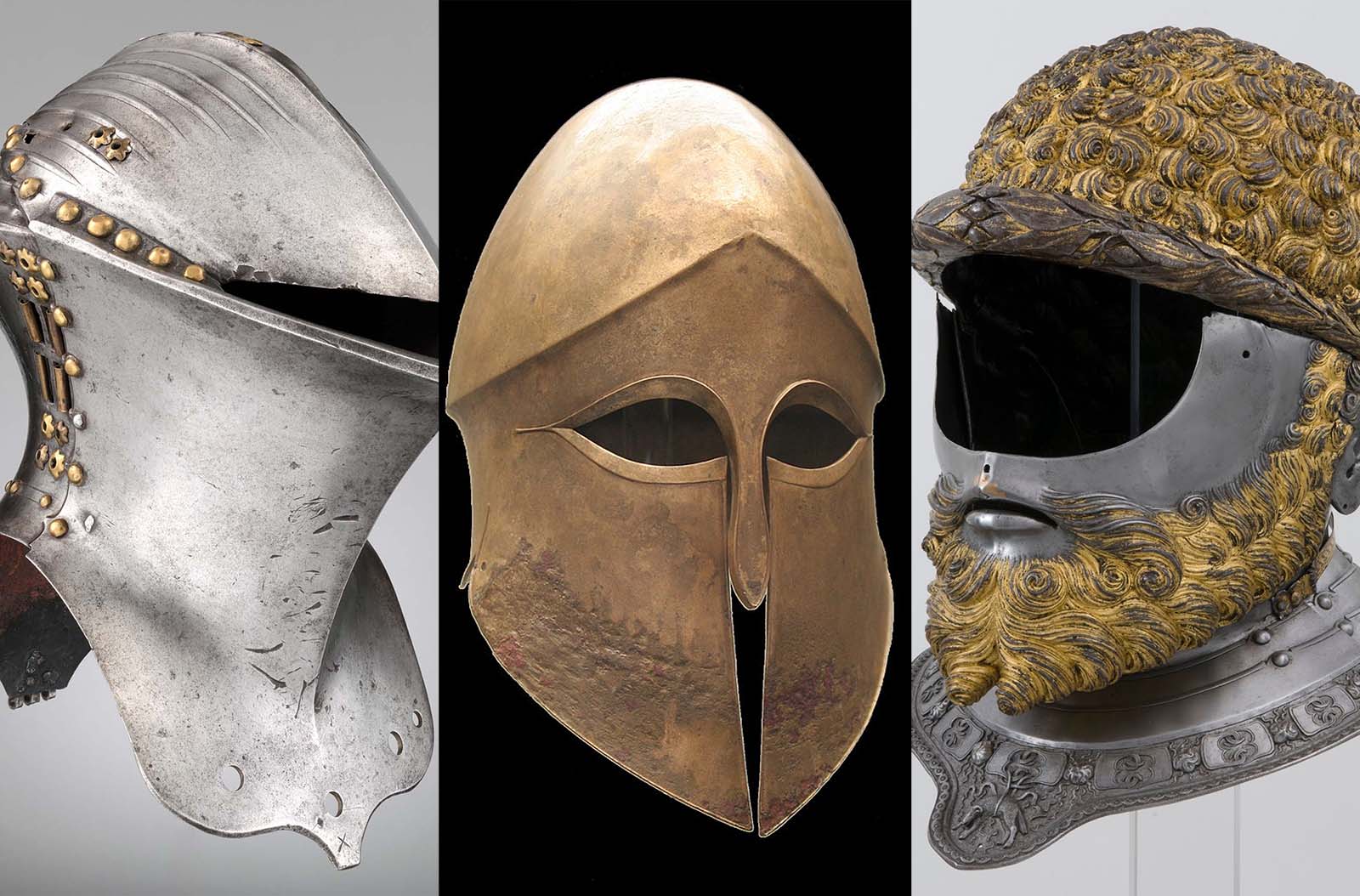
Helmets have been an important part of military history for thousands of years, with ancient civilizations around the world developing their own unique designs to protect their warriors in battle.
From the earliest known examples in the Bronze Age to the intricate helmets of the Classical world, the history of ancient helmets is a fascinating and complex story.
The earliest helmets were made of leather or cloth, but the development of metalworking allowed for the creation of more effective and durable helmets.

Charles V’s Nemean Lion Parade burgonet. Made by Filippo Negroli in Milan c. 1541.
The earliest known metal helmets date back to the 8th century BCE and were made of bronze, such as the iconic Corinthian helmet used by ancient Greek warriors.
These helmets covered the entire head, leaving only the eyes and mouth exposed, and often had a crest or plume on top for decoration. The Greeks also used other helmets such as the Attic and Boeotian types.
The Roman Empire also made use of helmets, with the Galea being one of the most recognizable designs. The Galea was made of bronze and had a wide brim that protected the neck and ears, as well as cheek guards and a visor that could be raised or lowered.
Roman helmets were often decorated with colorful plumes or other adornments, making them as much a symbol of status as a piece of protective gear.
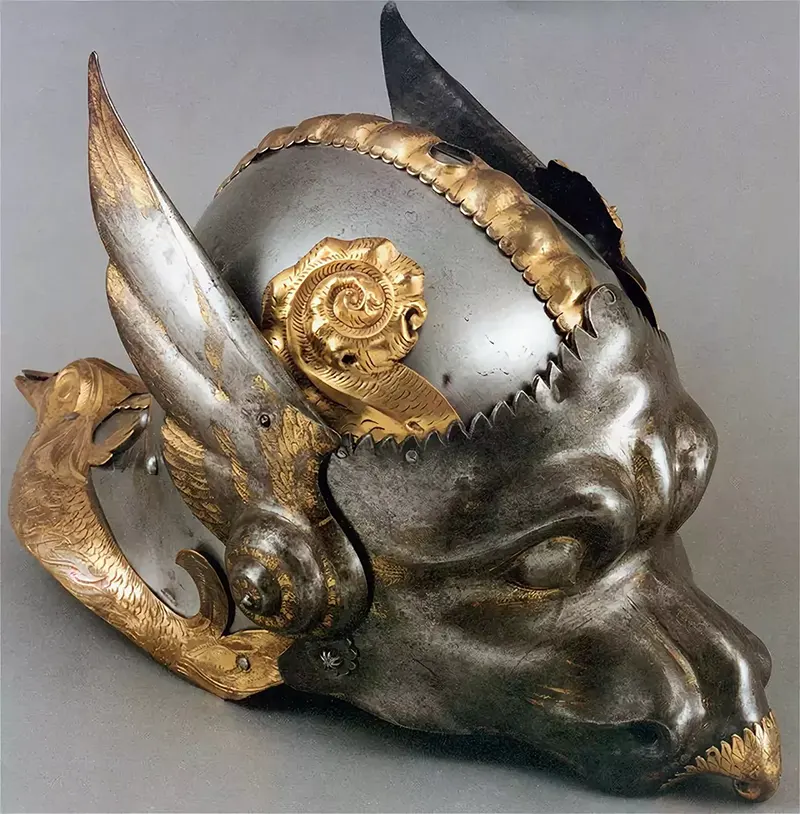
Emperor Charles V’s helmet. It was crafted by Desiderius Helmschmid, who was a member of the Helmschmieds of Augsburg which was one of late medieval Europe’s foremost families of armorers, c.1540.
In the Middle Ages, helmets continued to evolve to better protect the wearer. The European knight’s helmet, also known as the Great Helm or the Crusader Helm, was a popular design in the 12th and 13th centuries.
This helmet was made of steel and had a conical shape that covered the entire head, often with a visor that could be raised or lowered.
Other types of medieval helmets included the bascinet, which had a more rounded shape and could be worn with a separate visor, and the sallet, which had a more pointed shape and covered the back of the neck.
As warfare became more complex and firearms were introduced, helmets continued to evolve to provide greater protection.

Emperor Charles V’s burgonet helmet. It was crafted by Kolman Helmschmidc who was also a member of the Helmschmieds of Augsburg, c. 1530.
During the Renaissance period, helmets were designed with fluting or ridges to help deflect bullets and improve their strength.
In the 17th and 18th centuries, helmets were often worn by soldiers, but they were primarily ceremonial and decorative rather than functional.
Today, helmets continue to be an important part of military equipment, with modern designs incorporating advanced materials and technologies to provide the highest level of protection for soldiers and other personnel.
From the earliest leather and cloth helmets to the sophisticated designs of the modern era, the history of ancient helmets is a testament to human ingenuity and the enduring need for protection in times of war.

Gala armour of the Italian general Alessandro Farnese, Duke of Parma and Piacenza (1545-1592), workshop of the armoraro Lucio Piccinino, Italy, 16th century, Vienna, Kunsthistorisches Museum.

Armour of the Italian general Alessandro Farnese, Duke of Parma and Piacenza.

Armour of the Italian general Alessandro Farnese, Duke of Parma and Piacenza.

Horned Helmet of Henry VIII.
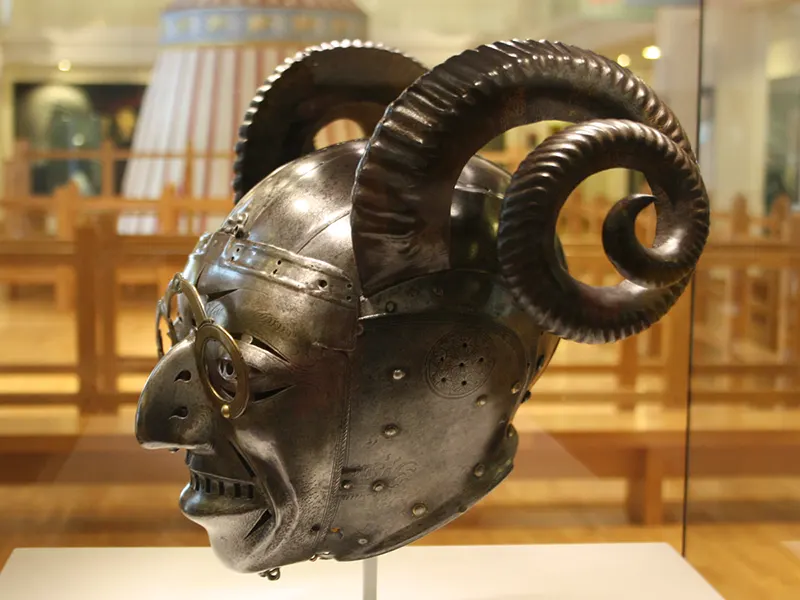
Horned Helmet of Henry VIII. Royal Armouries, Leeds – October 2015: Horned Helmet of Henry VIII.
One of the most mysterious objects in the Royal Armouries’ collection is the ‘Horned Helmet’, made for Henry VIII. It formed part of a magnificent armor, commissioned in 1511 by the Holy Roman Emperor Maximilian I as a gift for the young king, who would have worn the armor for court pageants rather than in combat.

The decoration on the grotesque mask is etched, with life-like facial details even down to the stubble on the chin and crow’s feet around the eyes, and there is a pronounced drip beneath the nose.
The mask is complete with a pair of spectacles, which heighten further the strangeness of this helmet. A pair of ram’s horns, beautifully modeled in sheet iron, complete this extraordinary piece and make it so remarkable that it was chosen as the object to represent the Royal Armouries museum in Leeds when it first opened in 1996.

Charles the V’s ceremonial close helmet. Made by The Helmschmieds of Augsburg c. 1540.
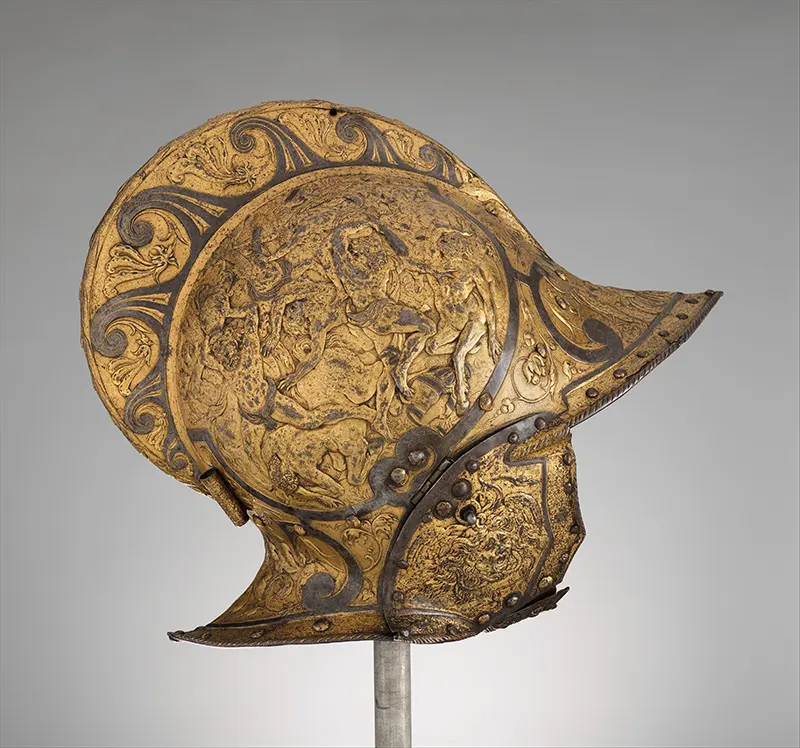
Burgonet with Falling Buffe and scenes of battle between the Lapiths and the Centaurs, c. 1555
The medallions on either side of the bowl are embossed with scenes from Greek mythology depicting the Battle of Centaurs and Lapiths, a popular subject in Renaissance art.
The compositions derive in part from design by Rosso Fiorentino (1494–1540), one of the Italian artists called to Fontainebleau to work for the French court.
Probably made for Henry II of France (reigned 1547–59), the helmet passed as a diplomatic gift to the Medici court in Florence later in the sixteenth century.
It is illustrated in a portrait of Cosimo II de’ Medici (1590–1621), grand duke of Tuscany, in the Metropolitan Museum’s collection (acc. no. 22.150). (From Metmuseum).
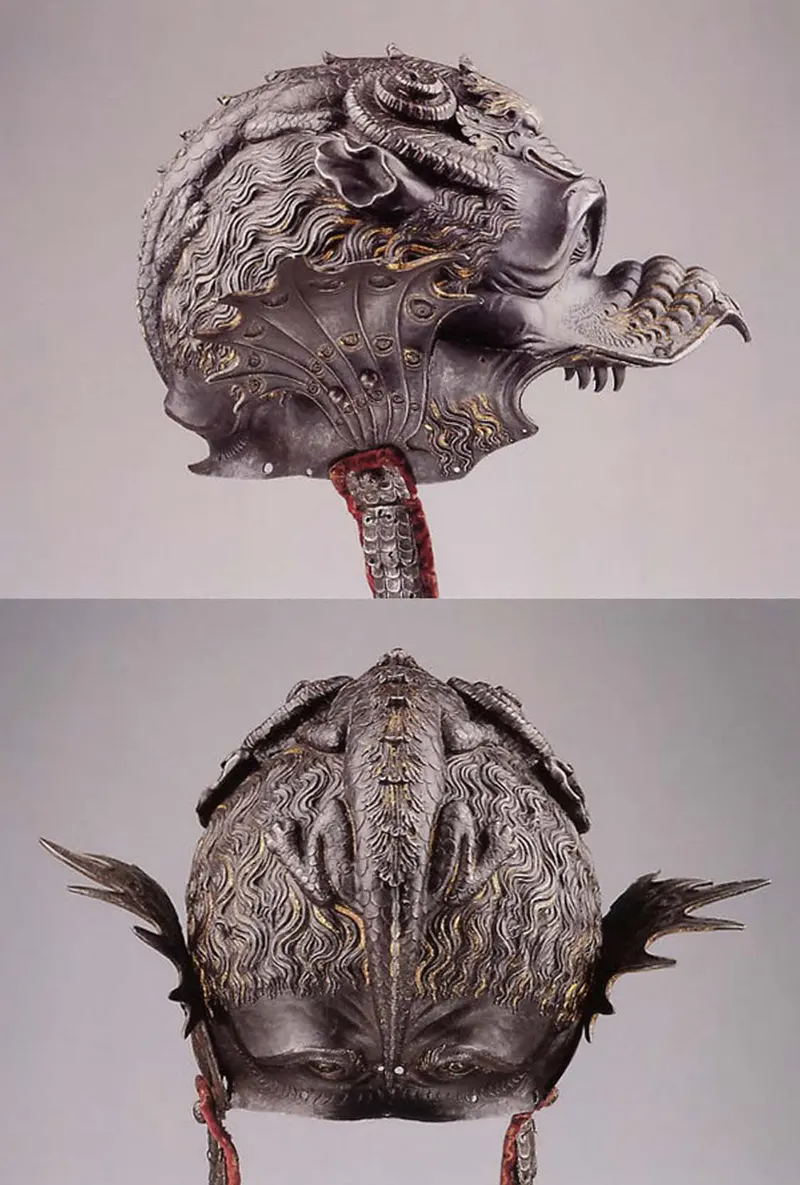
Burgonet of Guidobaldo II della Rovere, Duke of Urbino, Milan, c. 1532-35
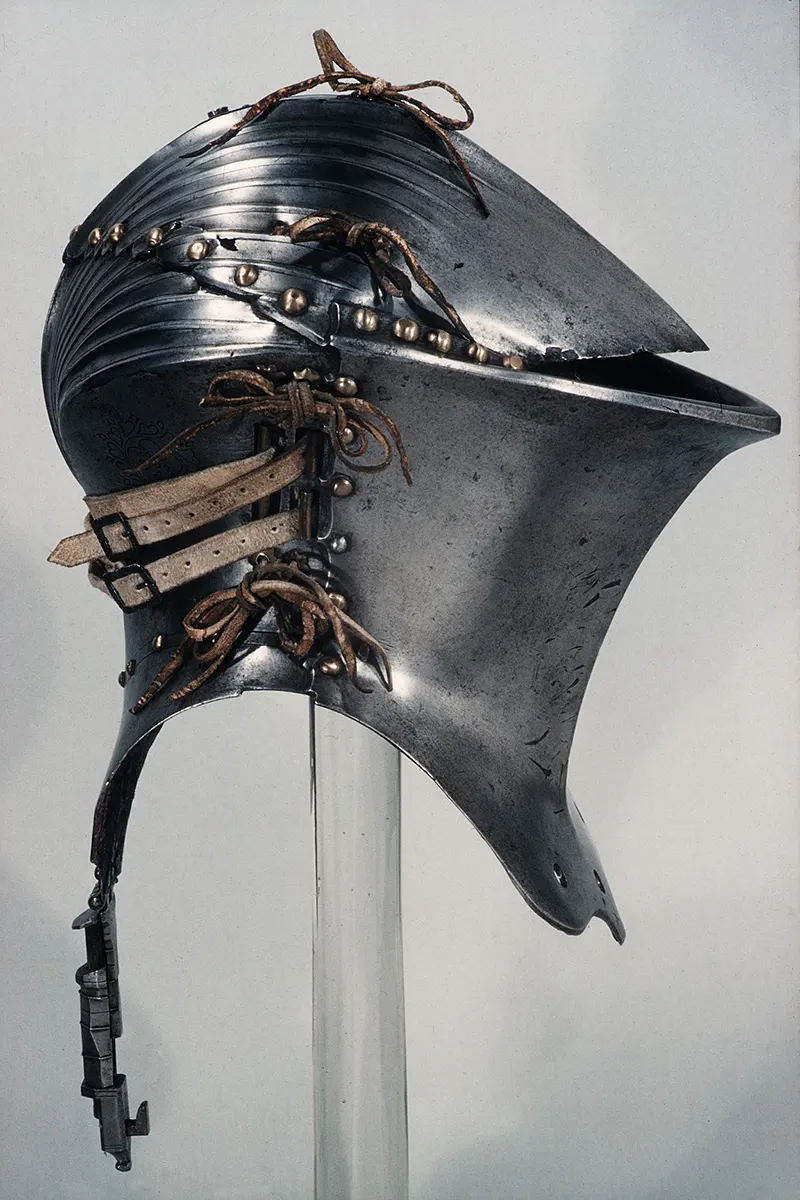
Helm for the Joust of Peace (Stechhelm), German, probably Nuremberg. 1500s.
The frog-mouth helm (or Stechhelm meaning “jousting helmet” in German) was a type of great helm, appearing from around 1400 and lasting into the first quarter of the 16th century. The helmet was primarily used by mounted knights for tournaments (jousting) rather than on the battlefield.
The frog-mouth analogy was drawn from the way the ocularium (the slit through which the wearer of the helm could see) resembles the open mouth of a frog.
During jousting tournaments, the helmet offered a better degree of protection from lances that would splinter after impact with the rival’s body armour.
Early examples of the stechhelm were made from a single piece of metal, while later dated helmets had hinged constructions that could be disassembled.
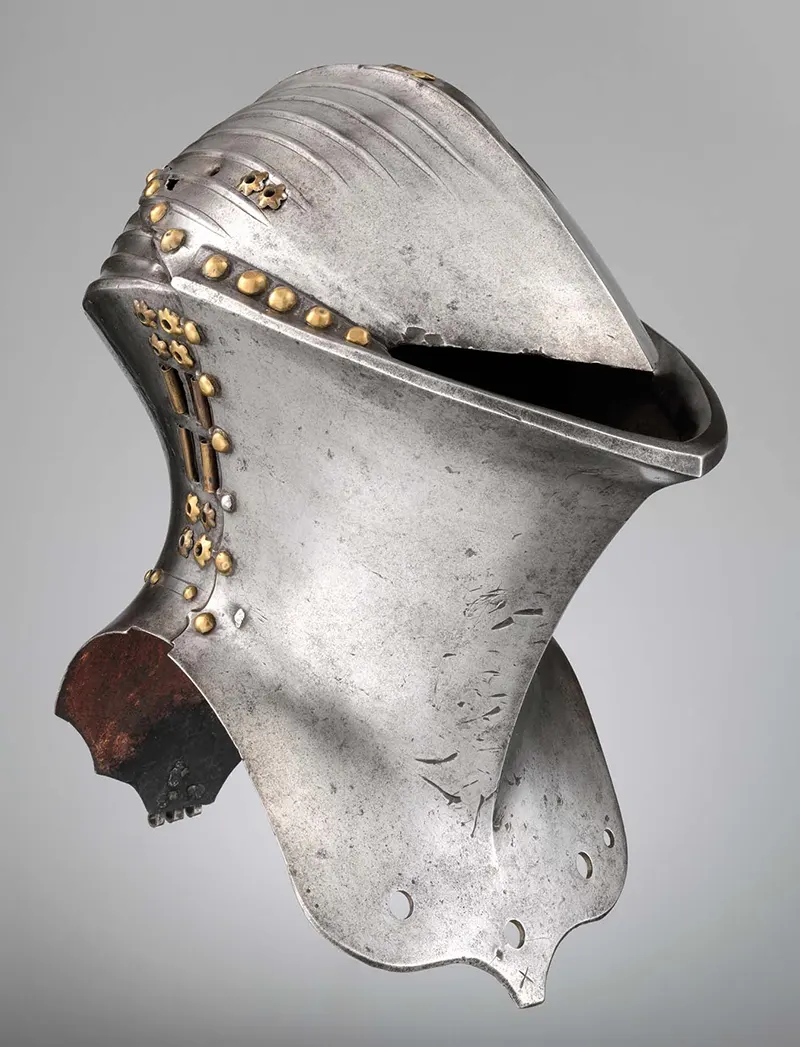
The frog-mouth helm.
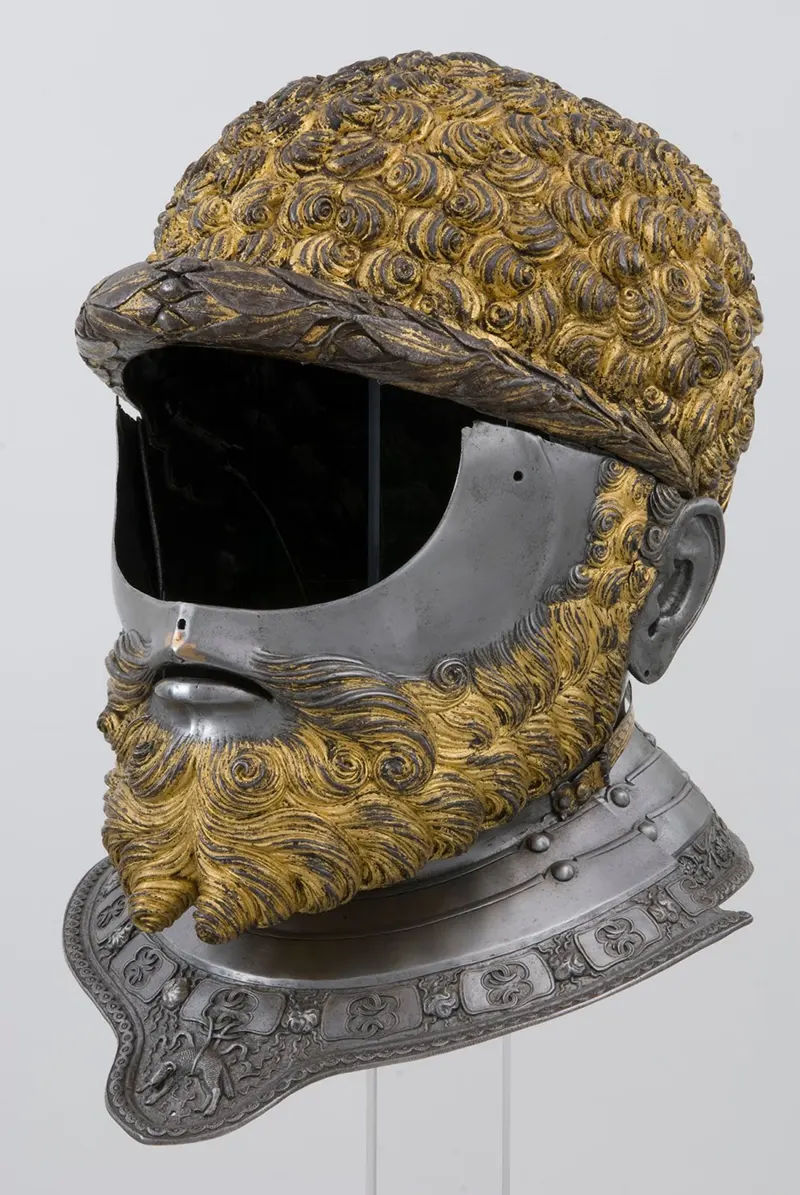
Helm of Emperor Charles V (Charles I of Spain), 16th century. Royal Armory, Madrid.
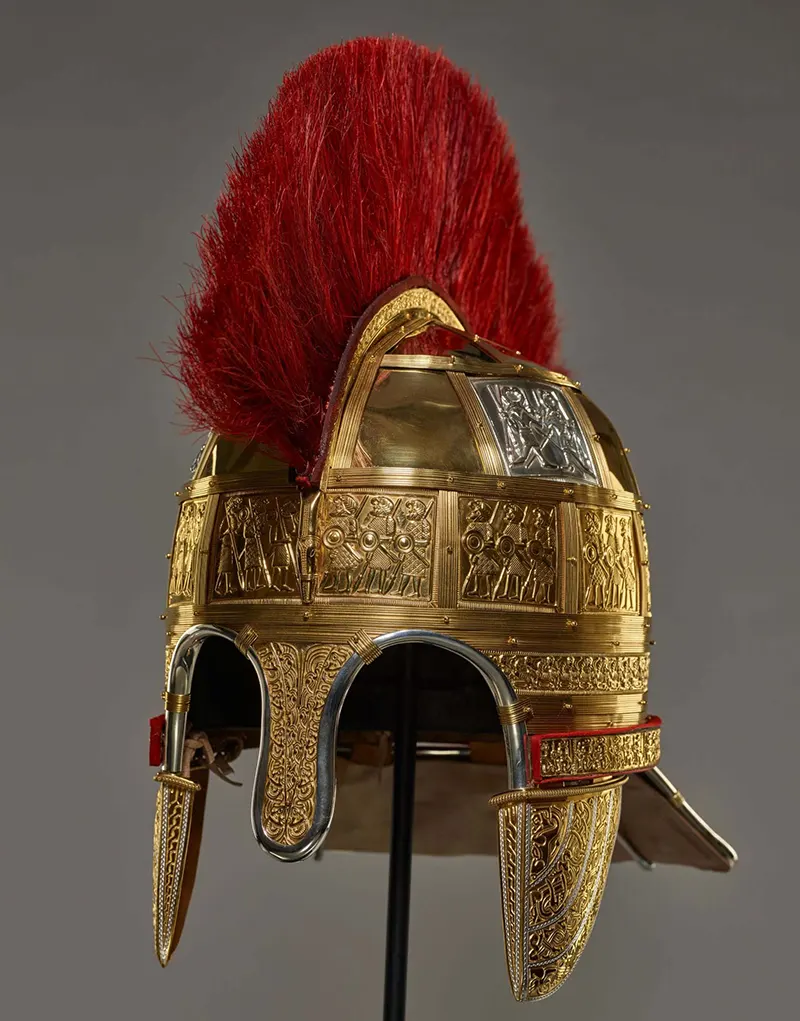
An Anglo-Saxon Helmet of gold and silver from the 7th century. (Photo by Birmingham Museums Trust).
A rare Anglo-Saxon Helmet of gold and silver from the 7th century reconstructed from fragments found near Lichfield, England.
The Staffordshire Hoard is the largest collection of Anglo-Saxon gold and silver ever discovered, held by the Birmingham Museums Trust.
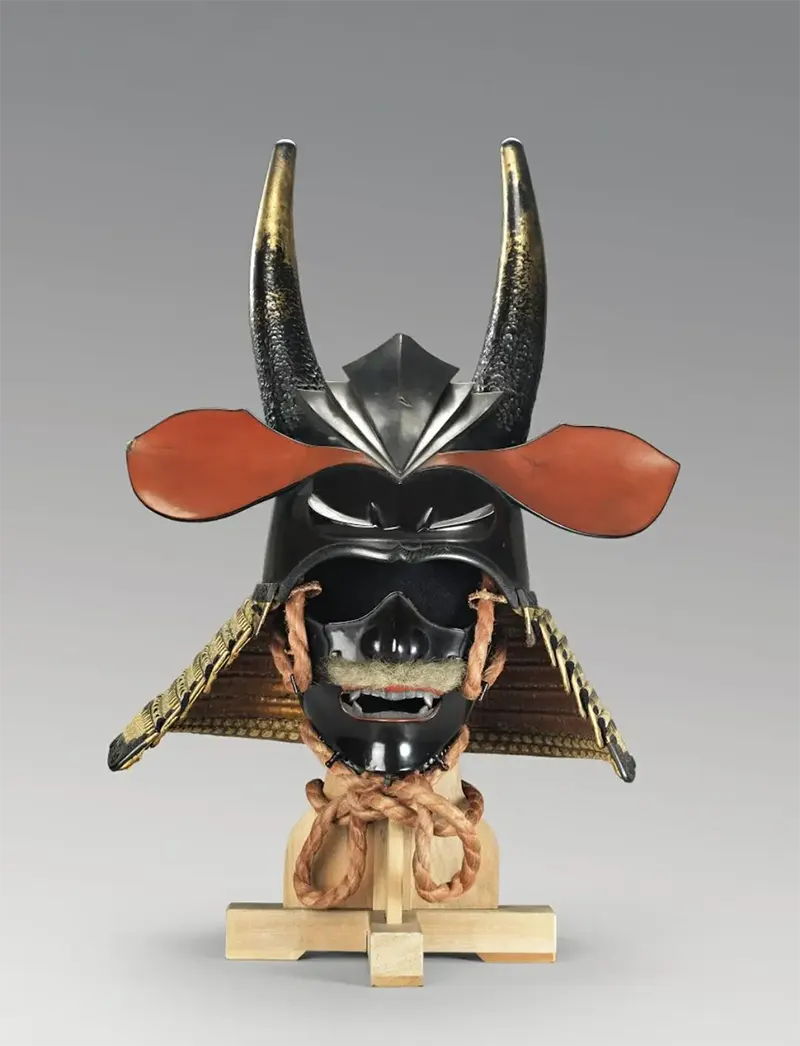
Samurai Helmet Samurai helmet(Kawari Kabuto) with buffalo horns, ears, and a devilish mask.
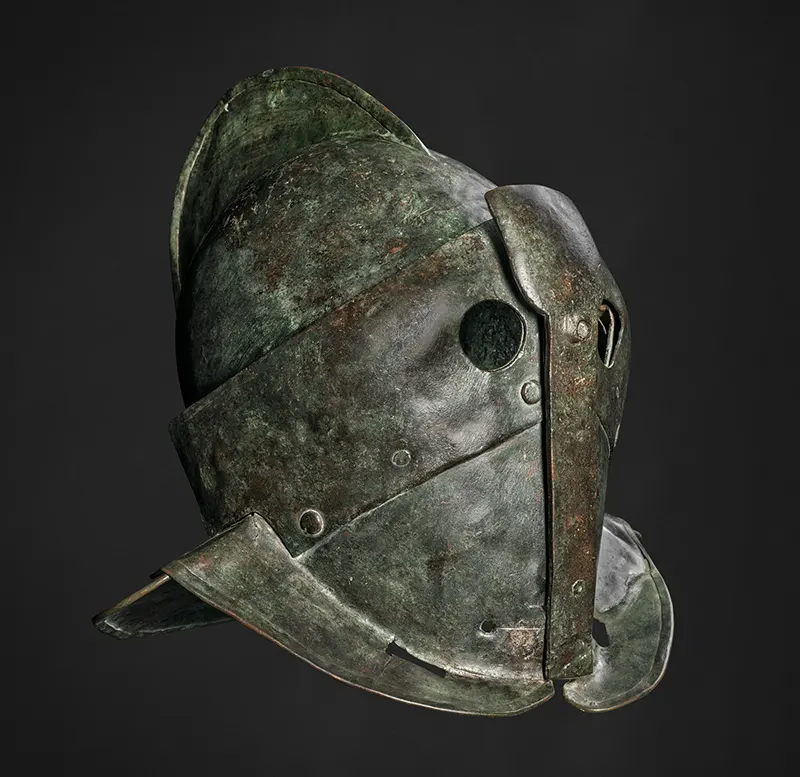
The helmet of a secutor, a type of gladiator, which will be on display at the Queensland Museum. The object was found in the Ludus Gladiatorius barracks in Pompeii. (Photo by Rogvi N. Johansen).

Warrior helmet found in the grave. 7th century AD, Sweden.

Bronze Corinthian helmet, c. 500 BCE, Staatliche Antikensammlungen.
The Corinthian helmet originated in ancient Greece and took its name from the city-state of Corinth. It was a helmet made of bronze which in its later styles covered the entire head and neck, with slits for the eyes and mouth. A large curved projection protected the nape of the neck.
Out of combat, a Greek hoplite would wear the helmet tipped upward for comfort. This practice gave rise to a series of variant forms in Italy, where the slits were almost closed, since the helmet was no longer pulled over the face but worn cap-like.
Although the classical Corinthian helmet fell out of use among the Greeks in favour of more open types, the Italo-Corinthian types remained in use until the 1st century AD, being used, among others, by the Roman army.

A Negroli helmet in the form of a dolphin mask, 15th century.

Samurai demon head-shaped helmet with hair, 17th century.

Helmet embossed in the form of a conch shell (awabi uchidashi kabuto), Japan, 1618. Made by Nagasone Tojiro Mitsumasa.

Decorative helmet of Gjergj Kastrioti Skanderbeg, c. 1460. Bought for Skanderbeg by Archduke Ferdinand II. Unknown artist, of Italian manufacture, possibly from Urbino.
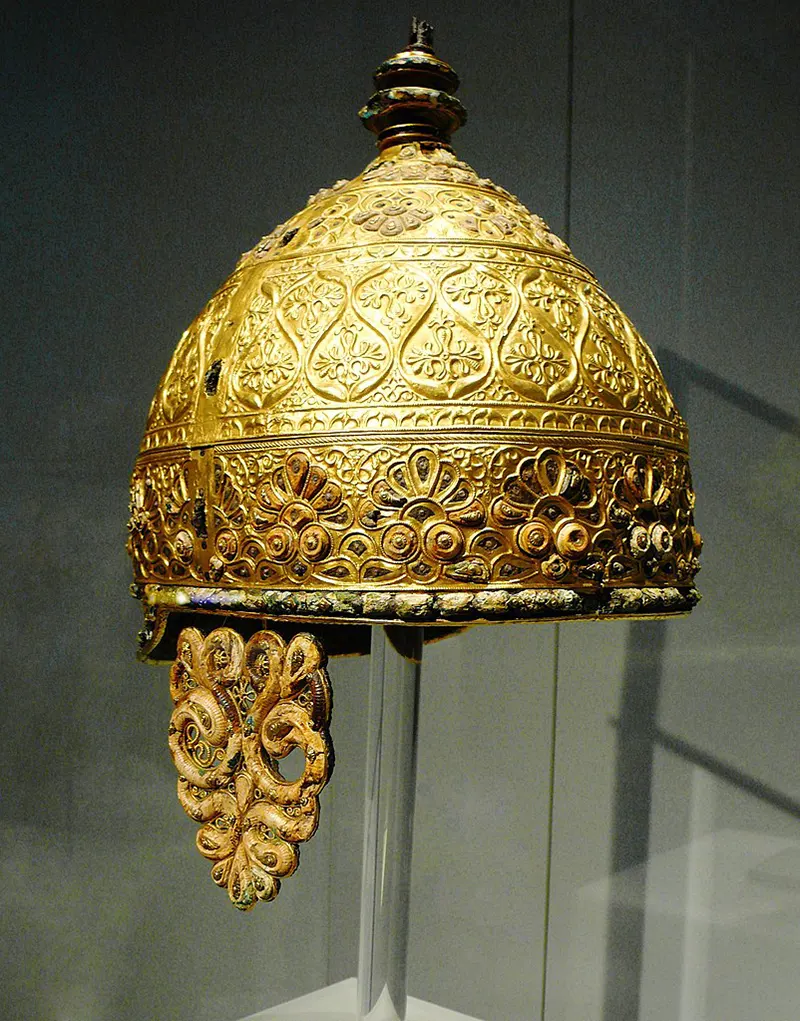
Celtic (Gallic) parade helmet, 350 BCE.
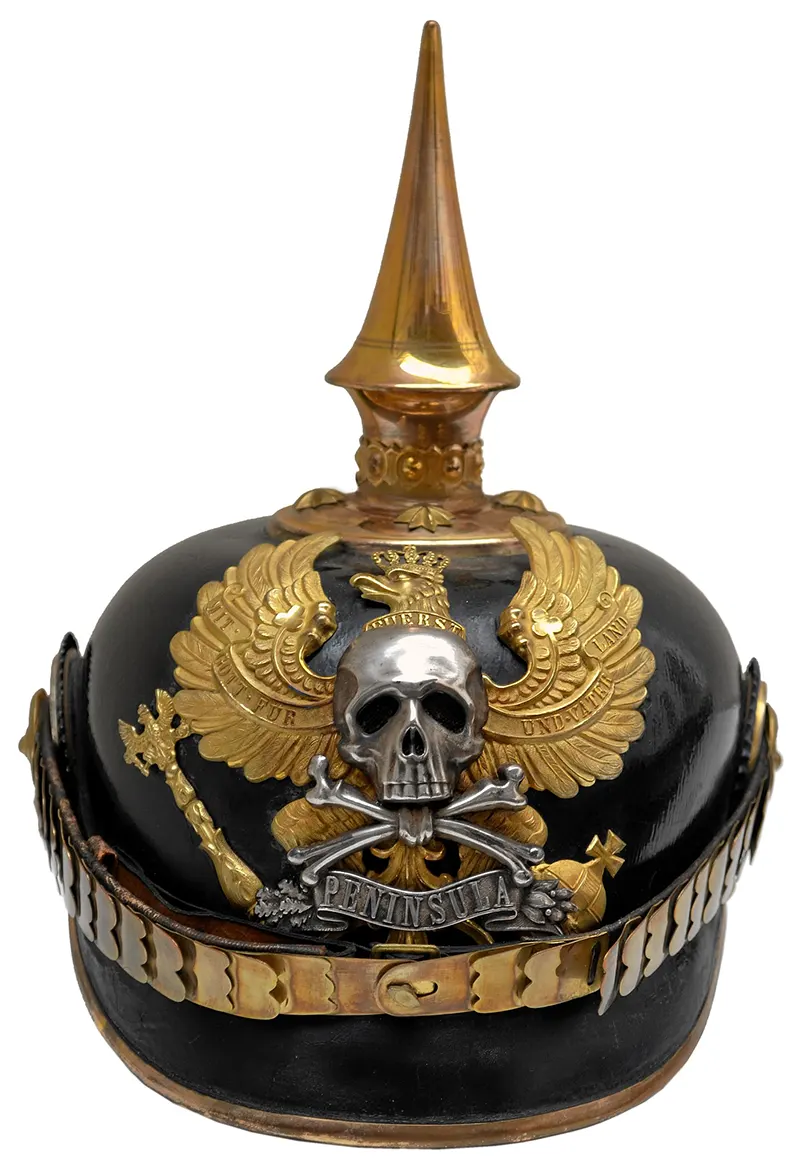
German Pickelhaube.

Ottoman zischagge helmet, mid-16th century.
As the coat of arms was originally designed to distinguish noble combatants on the battlefield or in a tournament, even while covered in armor, it is not surprising that heraldic elements constantly incorporated the shield and the helmet, these often being the most visible parts of a knight’s military equipment.
The practice of indicating peerage through the display of barred or grilled helmets first appeared around 1587-1615, and the heraldic convention of displaying helmets of rank in the United Kingdom, which came into vogue around Stuart times, is as follows:
- Sovereign: a gold barred-face (tournament) helm placed affronté
- Peer’s helmet: silver barred-face (tournament) helm placed in profile
- Knight’s or baronet’s helmet: steel helm (earlier jousting helm, later close helm) placed affronté with visor open
- Esquire’s helmet: steel helm placed in profile with visor closed
Earlier rolls of arms reveal, however, that early heraldic helmets were depicted in a manner faithful to the styles in actual military or tournament use at the time.
(Photo credit: Wikimedia Commons / Pinterest / Flickr / Britannica).
Updated on: March 28, 2023
Any factual error or typo? Let us know.



